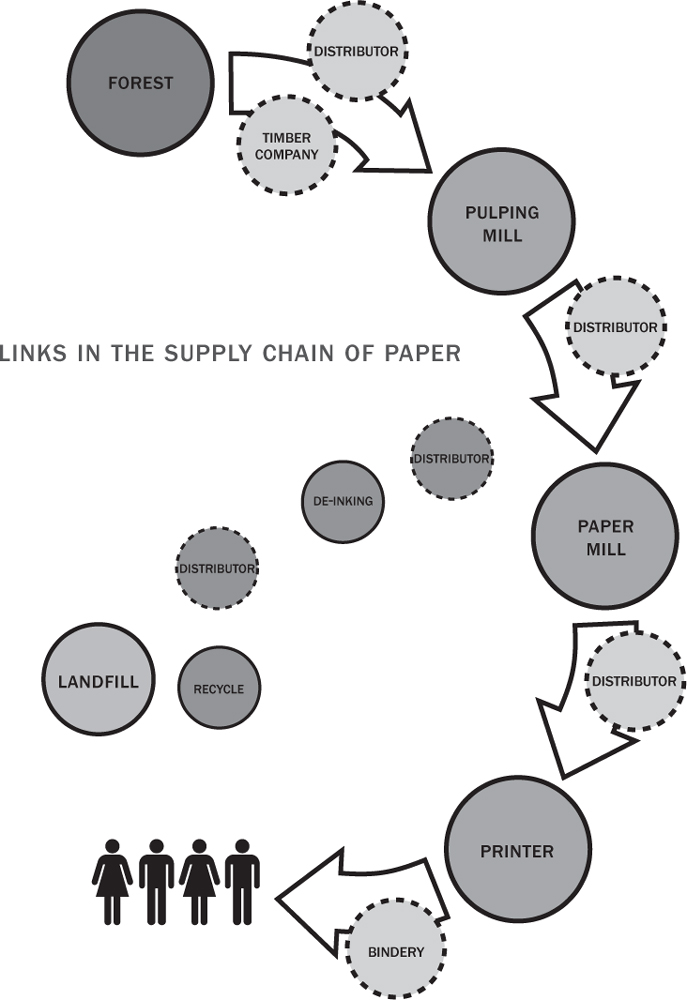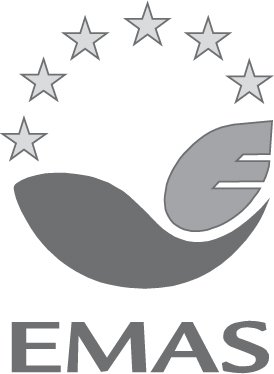Chapter 14: Greening Graphic Design
THE SHIFT TOWARD SUSTAINABLE PRACTICE
Sustainable graphic design can provide an opportunity to tap into an emerging market, work with clients who have similar values, and reduce the negative impact that print design has on the environment. For most designers, the transition to sustainable practice begins with a shift in thinking and the adoption of better production methods but will not require a complete alteration of their design process. This chapter will explain the basics of environmentally and socially responsible communication design and provide information and targets for how designers can become sustainable practitioners.
Sustainability refers to the balanced use of natural, social, and economic resources for the continued health of the planet for future generations. This means minimizing the use of processes and materials that will jeopardize the ability of future generations to survive and thrive.

Related Terms:
Green Design, Ecofriendly, and Ecodesign are frequently used in place of, or in addition to, the term sustainable when referring to processes, concepts, and materials that put value on environmental responsibility. It is important to understand that there is a distinction between something that has been labeled green or that uses the prefix eco- and the term sustainable. The former primarily refers to a concern for the environment while sustainability refers to a balance of social, economic, and environmental capital.
Socially Conscious Design
There is little point in making a hard distinction between socially and environmentally conscious design since sustainability requires the melding of the two. However, there is an emerging specialization in design for social causes and nonprofits. Working with clients that share your values can be a great way of shifting toward sustainable practice.
Subtle shifts in how graphic designers approach projects can significantly shift one’s practice in line with sustainable values. Pairing environmentally responsible production with design thinking can be as easy as asking questions about each project you take on and by adhering to the following guidelines.
STEP 1: GREENING YOUR STUDIO
• Use recycled and Forest Stewardship Council (FSC) certified office paper.
• Switch to renewable energy and use compact fluorescent bulbs.
• Educate employees and coworkers about sustainable options.
STEP 2: EVALUATE THE PROJECT
• Does this piece deserve to exist? (Will it serve its intended goal?)
• Can this piece serve dual purposes? Can fewer pieces be printed? Can it be digitally distributed with PDFs?
STEP 3: DESIGN FOR A GREENER SOLUTION
• Adjust size of printed materials to minimize waste on a press sheet.
• Ask for water based adhesives instead of glues with synthetic resins that release VOCs.
• Consider how to the consumer can re-use or recycle the package/product. Include recycling instructions if the materials can be easily recycled.
• Design for minimal ink coverage (effective use of white space).
• Proof on screen when possible.

• Put the recycled logo and other pertinent certifications on the final piece to promote recycling and to educate the consumer.
• Educate clients about sustainable options and advocate for ecofriendly production.
STEP 4: GREEN PRODUCTION
• Use the services of an environmentally responsible printer.
• Use digital or waterless printing when possible.
• Spec recycled or FSC certified paper, ecofriendly bindings, and water-based finishes.
SUSTAINABLE MATERIALS AND PRODUCTION FOR PRINT DESIGN
Specifying environmentally preferable printing processes and materials can greatly reduce the negative impact that graphic designers have on environment and social systems. Paper production and printing are both resource intensive processes. They use a tremendous amount of energy, potentially harmful chemicals, and can negatively affect local air and water quality. Since 75 percent of communications pieces end up in landfills within one year, using the most environmentally responsible paper products and working with a printer that is concerned about energy use and water and air quality is essential.
FORESTRY
As the first step in the lifecycle of paper, commercial forestry and environmental management have an important role to play in designers’ abilities to work sustainably. One of the most common misconceptions about forestry is that planting new trees is equivalent to saving forests. That is simply not the case. In the United States, millions of new trees are planted each year, and annual plantings actually exceed the number of trees cut for industrial purposes. However, these plantations do not have the same benefits as natural forests.
Old growth forests, which include boreal and rainforests, are forests that have been allowed to grow naturally for more than one hundred years and that have developed into complete ecosystems containing every stage of tree life as well as the appropriate bio-diversity of other plants and animals. Intact forests have not been significantly disturbed by fire, logging, clear cutting, road building, or other human activity. The difference in the environmental and societal benefits of plantation tracts versus old growth forests are enormous, and around the world community groups, nongovernmental organizations (NGOs), and governmental organizations are working to minimize the destruction to the remaining intact forests.
Why Tree Fiber Is Still Needed
It might seem that discontinuing the use of virgin fiber (fiber that comes directly from its organic source) in paper production would be the best way to combat deforestation and illegal logging. Unfortunately, there is not enough recycled waste paper to satisfy global demands nor has any other agricultural crop proved to be a viable alternative to fiber from wood sources. For the foreseeable future there will continue to be a need for forest products from virgin sources.
In the case of larger companies and integrated mills, many of the following steps may come under the umbrella of one company. However, in some cases there can be up to ten different companies involved in the supply chain of print production.
SUSTAINABLE VOCABULARY
Understanding the relevant terms can be one of the biggest stumbling blocks to adopting sustainable practices. The following are some of the most common terms that designers will encounter when specing paper and reading about sustainability issues.
Agricultural Fibers are harvested from tree-free organic sources that are grown specifically for use in paper production; often bears the Tree Free label.
Agricultural Residues are fibers recovered from annual crops usually planted as food crops or for commercial use (such as corn, sugar cane, and wheat) that is used to make paper. The use of these fibers is usually limited to areas where crops are grown locally.
Carbon Dioxide is a heavy, colorless, odorless gas that results from the combustion of carbon found in organic materials. Carbon dioxide is the gas most closely associated with global climate change.
Chlorine is used in the bleaching process to give paper its white appearance and to remove lignin, a naturally occurring material that can gradually yellow when exposed to sunlight, as in newsprint.
De-inking is the process of removing ink and other contaminants from collected paper. De-inking is usually done at a separate facility and finished fiber is sent to paper manufacturers.
Dioxins are a group of toxic substances that are produced during the paper production processes when pulp is exposed to elemental chlorine. The effects of dioxins on the environment and human health are not fully understood but have been associated with cancer and birth defects.
Effluent is waste in liquid (most often water) that is discharged from a mill, or other manufacturing facility, and can end up in the groundwater.
Elemental Chlorine Free (ECF) indicates fibers that have been bleached without elemental chlorine and is instead made with chlorine derivatives such as chlorine dioxide (CO2).
The Forest Stewardship Council (FSC) is an independent third-party certifier of sustainably harvested virgin fiber and mixed-use recycled content. To use the FSC logo as an environmental claim on paper, the product must have gone through the FSC chain of custody from an FSC-certified forest, to a paper manufacturer, merchant, and finally printer who has FSC chain-of-custody certification.
Mill Broke is paper waste generated by a mill that can be reused in the manufacturing process. Mill broke may contain a fairly large percentage of recycled content so it is preferable to ask what percentage of the recycled content is derived from postconsumer waste content and where the rest comes from. (Also see Preconsumer Waste)
Old Growth, also called intact forests (included in this category are boreal and rainforest), are natural forests that have been allowed to grow naturally over a long period of time (in excess of 100 years) and have developed into complete ecosystems containing every stage of tree life as well as the appropriate biodiversity of other plants and animals.
Postconsumer Waste (PCW) is paper that has been used by the consumer and then collected to make new material (rather than end up in a landfill or incinerator). This is what most people think of as recycled paper.
Preconsumer Waste refers to materials that include trim or scrap from the manufacturing process and printers or even overruns that are reused to make new products. This may account for as much as 20 percent of paper referred to simply as recycled. (Also see Mill Broke)
Processed Chlorine Free (PCF) is used to refer to fiber that was not bleached using chlorine or chlorine derivatives during the recycling process but may have been bleached using chlorine during the paper’s initial production and, therefore, may not be totally chlorine free.
Recycled Paper is derived from either pre- or postconsumer waste. Recycled pulp can be used to make the same variety and quality of paper stock made from virgin fiber. However, not all recycled material is equal and some fibers (such as cardboard or colored papers) may be better suited for reuse in packaging stock.
TCF and PCF both use benign elements such as oxygen, ozone, or hydrogen peroxide for the bleaching process. Most scientists and environmentalist believe that Totally Chlorine Free production is preferable to Elemental Chlorine Free bleaching.
Totally Chlorine Free (TCF) indicates fibers that have been produced without the use of any chlorine in the bleaching process or is unbleached.
Tree-Free includes paper products made from agricultural residues, nontree fibers, and, more recently, products made from minerals and plastics. Note: Tree-free does not necessarily denote more environmentally preferable products.
Volatile Organic Compounds (VOCs) refers to a broad class of organic gasses that includes vapors from solvents, inks, and gasoline. Minimizing or eliminating the use of products that produce VOCs is important because these compounds can react with other materials to form ozone, the major ingredient of smog.
Virgin Fiber refers to paper pulp fiber that is derived directly from its organic source (mostly refers to wood fiber). This material can be an environmentally responsible choice when it is third-party certified (FSC) and comes from sustainably managed forests.
FIBER SOURCING AND PAPER PRODUCTION
The harvesting of trees for pulp production and the conversion of pulp into finished paper are responsible for the bulk of the negative environmental impact made by the paper industry. Paper production and the sourcing of fiber are two of the most important areas to target when adopting sustainable design practices.
Ideally, the paper that you choose should be produced with a combination of post-consumer recycled content and virgin fiber from sustainably managed forests (FSC certified). It should be made without the use of elemental chlorine by a company that uses renewable energy. Targeting these areas may be as simple as comparing different sheet specifications with a knowledgeable printer. However, understanding the touch points for paper production and forestry can make the process easier especially since the minimum criteria for sustainable production are neither stable nor clearly defined.
Sustainable Forestry and the FSC
Each year, thousands of acres of forestland are felled and/or burned for use by the timber industry to make way for agriculture, and to satisfy growing global demand for land by urban populations. CO2 emissions generated by deforestation make up 20 percent of the annual total. Discontinuing the use of virgin tree fiber (fiber that comes directly from its organic source) in paper production might seem to be the best way to combat deforestation and illegal logging. However, there is currently no crop that has proven to be a viable alternative to fiber from wood sources.
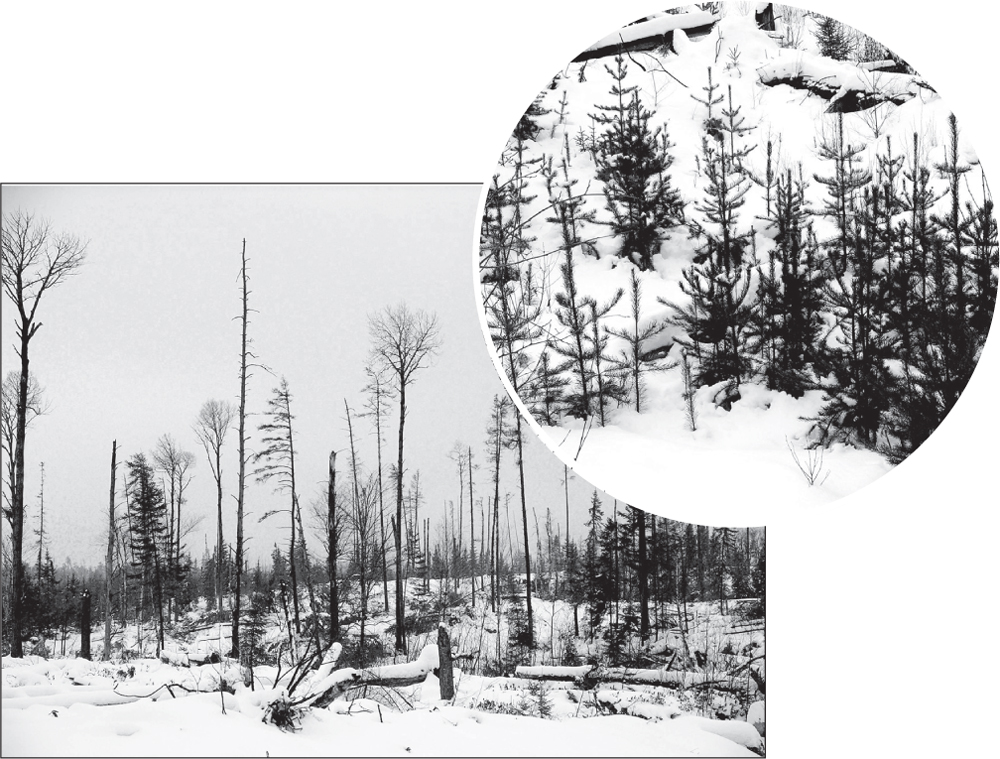
Domtar, a paper company based in Montreal, Canada, uses sustainable logging practices when harvesting trees for pulp and paper production. After timber is harvested, sites are prepared and seeded from the air for regeneration of the Jack pine forest. The seed to regenerate these sites is obtained by cone collectors from the tops of trees felled on cuts. To help maintain natural genetic adaptations in regenerating forest stands, the seed or planting stock produced from the harvested cones is returned to the original ecological seed zone.
Fortunately, the impacts of commercial forestry can be greatly reduced if logging is conducted using sustainable forestry practices. Sustainable forestry is a system of managing both the commercial and environmental benefits of forests while maintaining economic, societal, and environmental values. By choosing paper and timber products from sustainably managed forests, graphic designers can support the environmental and social systems that are found in healthy forests while ensuring that the wood fiber found in the paper products that they use does not come from illegally or improperly harvested land.
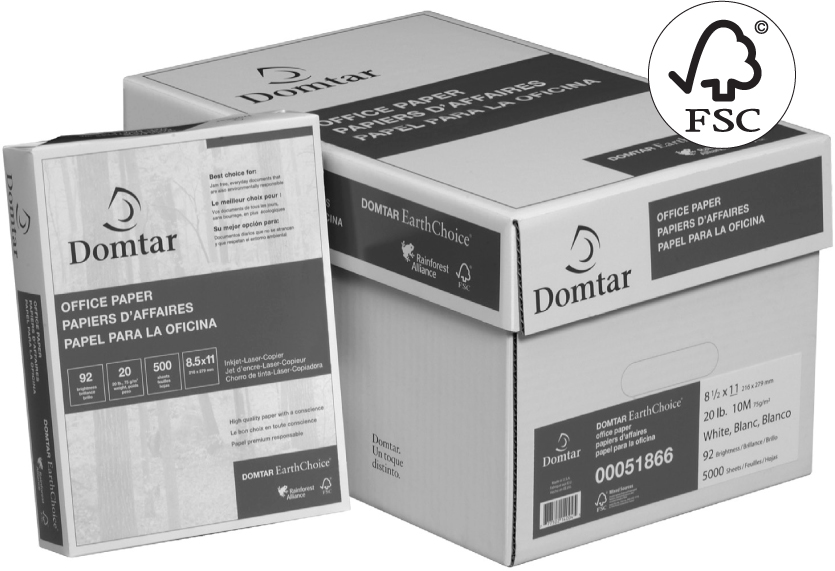
Look for wood products and paper with the FSC logo on it. These boards and Domtar paper were FSC certified by Rainforest Alliance, (an FSC certifying partner organization).
The most respected and widely recognized international certification body for wood products is the Forest Stewardship Council. The FSC uses accredited third-party certifiers to assess the environmental performance of manufacturers, distributors, retailers, and printers against the FSC’s performance standards. Using a chain-of-custody system, FSC bases its assessment on ten principles and criteria for forest management that were developed collaboratively by foresters, forestry companies, consumer and retail companies, environmental and social organizations, and community forestry groups.
FSC works with partners around the world to ensure that forest ecosystems remain intact even after an area is logged. It does not certify large-scale logging practices such as clear cutting.
CERTIFICATIONS
One of the easiest ways to achieve more environmentally friendly print production is to use products and services that are assessed using independent third-party certifications. The organizations responsible for the most widely used certifications often use logos and/or visual marks that allow consumers and purchasers to differentiate products quickly. International Organization for Standardizations (ISO), the European Union’s Eco-Management and Audit Scheme (EMAS), FSC, and Green E are examples of certifying bodies that guarantee that products or manufacturing processes meet a strict set of criteria. Though well-meaning industry trade groups make information available to consumers, it is easy to overlook or be confused by data or advice that comes from organizations with ties to industry. When choosing products or services, look for certifications that are conducted by independent third-party organizations such as the following.
Chlorine Free Products Association
Chlorine Free Products Association (CFPA) is a certification program for companies that produce chlorine-free products. A product bearing the Totally Chlorine Free (TCF) or Processed Chlorine Free (PCF) emblem is subject to ongoing testing, inspection, and enforcement. Learn more at chlorinefreeproducts.org.

PROCESSED CHLORINE FREE
The Processed Chlorine Free (PCF) seal is reserved for recycled content paper. This includes all recycled fibers used as a feedstock that meet Environmental Protection Agency guidelines for recycled or postconsumer content. PCF papers have not been rebleached with chlorine-containing compounds. A minimum of 30 percent postconsumer content is required.

TOTALLY CHLORINE FREE
Totally Chlorine Free (TCF) is reserved for virgin fiber papers. TCF papers do not use pulp produced with chlorine or chlorine-containing compounds as bleaching agents.
EMAS
The European Union Eco-Management and Audit Scheme (EMAS) is a management tool for companies and other organizations to evaluate, report, and improve their environmental performance. Learn more at www.ec.europa.eu/ environment/emas.
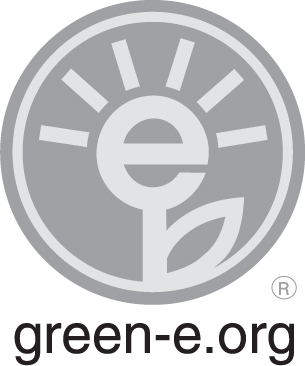
GREEN E
The Green E logo identifies products made by companies that purchase certified renewable energy to offset a portion or all of their electricity use. Renewable energy types include but are not limited to wind power, solar power, low-impact hydropower, and biomass. Learn more at www.green-e.org.

GREEN SEAL
Green Seal is an independent nonprofit organization dedicated to safeguarding the environment and transforming the marketplace by promoting manufacture, purchase, and use of environmentally responsible products and services. Printing and writing paper that are Green Seal certified have met rigorous criteria for product-specific performance, recycled content, production process, and packaging requirements. Learn more at www.greenseal.org.
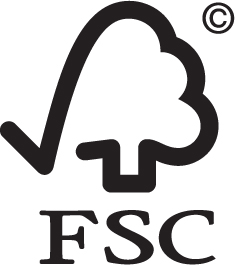
FSC
Forest Stewardship Council (FSC) is a nonprofit international organization established to promote the responsible management of the world’s forests. Products carrying the FSC label are independently certified to assure consumers that they come from forests that are managed to meet the social, economic, and ecological needs of present and future generations. Learn more at www.fsc.org (main site) and www.fsc-paper.org (list of FSC-certified papers).
ISO 9000 AND 14000 (NO LOGO TO DATE)
The International Standards Organization (ISO) is a nongovernmental organization made up of a network of the national standards institutes of 157 countries, which all participate in the development of international market-driven standards for industry.
ISO 9000 and 14000 are quality and environmental management standards that a company may choose to adopt. A company’s performance is evaluated against the ISO’s conformity assessment. ISO 9000 means that the organization in question has committed to enhance customer satisfaction by meeting customer and applicable regulatory requirements. ISO 14000 is a family of certifications that mean that the organization or company is committed to minimizing its harmful effects on the environment caused by its activities and continually improving its environmental performance. Learn more at www.iso.org.
Energy Conservation and Renewables
Energy sourcing and conservation are important variables for designers who want to work sustainably and can be targeted in the office, at the printer, and with materials chosen for production. Since paper production and printing are energy-intensive processes, it is particularly important that mills and printers utilize energy from renewable resources and conserve where possible.
Common Sources of Renewable Energy
• Solar
• Wind
• Landfill gas
• Biomass
• Geothermal
• Low-impact hydro
Renewable Energy for Paper Production

On average, paper mills use 33 million Btu of energy to produce 1 ton of paper—approximately the same amount of energy used by four U.S. families in one month.
Paper mills consume about 33 million Btu of energy to produce 1 ton of paper or paperboard. Some mills can make their own power from waste generated during the pulping process. (This may be considered renewable, but it is worth asking about air pollution if waste burning is part of the process.) Mills that don’t include pulping facilities and environmentally conscious printers may purchase energy from renewable sources. Renewable energy is a good alternative to power generated from nuclear or fossil fuel sources. The use of renewables, and the range of options available when specifying energy from alternative sources, means that there isn’t one certification or type of energy that is considered preferable. Fortunately, companies that use renewables are eager for the public to know about their environmental commitment and these products and services are almost always labeled or highlighted to consumers and purchasers.
PAPER PRODUCTION
Historically, paper production has been considered a dirty process that can negatively impact the environment at numerous points. However, in the last twenty years, govern-mental regulations, pressure from consumer and community groups, as well as investment by the industry itself has resulted in significant improvements to the environmental performance of many paper companies. Currently, areas of concern include water use, disposal of waste, energy sourcing, emissions, and the use of chlorine in paper production. Each mill deals with these issues differently and, in some cases, governmental regulations may prohibit the use of elemental chlorine and require mills to minimize any air and water pollution that is generated during paper production. However, energy conservation, sourcing from renewable sources, and the disposal of waste are rarely regulated. As energy has become more expensive, most mills have put conservation plans into place both for the sake of the bottom line and to minimize impact on the environment. Similarly, many mills have found ways to dispose of waste that include repurposing and reuse.

Keeping up with all of the issues associated with paper production may be unrealistic for most designers, but paper companies do provide spec sheets that make it possible to compare one product with another. Printers may also provide information and advice about which companies produce products that have the least environmental impact.
RECYCLED PAPER
Every sheet of paper that is recycled prolongs the use of this highly disposable material and keeps material out of overflowing landfills. There has been some controversy about the benefits of recycling because of several negative environmental impacts associated with the de-inking of paper. However, most environmental organizations and independent studies conclude that the benefits of recycling outweigh the negatives.
Unfortunately, the labeling of paper containing recycled content varies tremendously and there are no formal regulations on what percentage of reclaimed material a sheet must contain in order to be called recycled. Therefore, it falls on the shoulders of consumers and distributors to make sense of confusing and sometimes misleading labeling.
When evaluating reclaimed paper, the most important distinction to make is between preconsumer and postconsumer waste.
Preconsumer waste refers to scraps and ends from the manufacturing process, as well as test sheets and overruns from printers that are collected and remanufactured into new paper.
Postconsumer waste refers to material that has reached the consumer, been used, and then collected to make new product. It is postconsumer waste that people commonly think of when they want recycled paper. However, preconsumer waste is reported to comprise 20 percent of the reclaimed content used in paper today. Copy paper often has some percentage (usually 10 to 30 percent) of recycled content, and unless otherwise specified, this labeling may simply indicate that mill waste is being fed back into the manufacturing process. While preconsumer waste is an important indication that mills are being efficient, it is vital that companies properly label products so consumers understand where reclaimed content comes from.
De-Inking
Generally paper can only be recycled up to six times. However, some countries’ regulations and use of special inks have increased the number of times fiber can be used to nine. To achieve the bright white paper used for most printing projects, ink, adhesives, and other contaminants must be removed. As reclaimed material goes through the de-inking process, the natural wood fibers begin to break down and eventually only lower grades can be made from these shorter, weaker fibers. The exceptions are newsprint and cardboard, both of which can be produced with lower-quality reclaimed material that doesn’t necessarily need to be de-inked. Even when reclaimed material does have to be whitened, it is usually done with hydrogen peroxide, which is considered to be much less harmful than the bleaching done with a chlorine derivative.
One of the main environmental concerns associated with the recycling process is sludge that consists of leftover materials from the de-inking process. Though some mills reprocess sludge for use as fertilizer, the practice is controversial because sludge and the resulting fertilizer often contain the heavy metals from ink. Since reclaimed material may have been printed before environmental regulations took effect, even materials that are banned for use today can show up in sludge. The safe collection and disposal of de-inking waste is an important environmental concern. However when paper is de-inked, any toxic elements found from sludge are less likely to contaminate groundwater supplies than if waste paper was sent directly to landfills.
PAPER FROM MIXED SOURCES
Since recycling results in the degradation of wood fibers, adding some percentage of virgin fiber to reclaimed material can prolong the use of weakened fibers. It is common to find environmentally friendly paper that is derived from mixed sources. To accommodate this trend, the FSC has created a certification for paper that uses some percentage of recycled content combined with virgin pulp from sustainably managed forests. One hundred percent postconsumer recycled paper may have a cost premium associated with it because collecting and recycling waste paper is expensive and the demand is high. So using a sheet that is made with 20 to 40 percent postconsumer recycled waste with the remaining percentage coming from FSC certified sustainably managed virgin sources can provide the most cost-effective solution when specing ecofriendly paper.

Mixed Sources is a designation used for paper that combines virgin pulp from sustainably managed forests with recycled waste paper. Mixed source stocks can often represent the best price option when specing ecofriendly paper for production.
TREE-FREE PAPER
Tree-free paper is made using materials not derived from wood fibers. Tree-free paper can be divided into two types: organic tree-free paper uses material derived from plant sources such as residues from agricultural crops or plants grown specifically for papermaking such as hemp, bamboo, and kenaf. Nonorganic tree-free paper is usually made of plastic polymers or minerals. Even though tree-free papers have been around for several decades, they have yet to capture a significant share of the paper market. It is important to note that some manufacturers consider any paper that uses no virgin fiber to be tree-free even though some products may actually contain a sizable amount of recycled wood fiber. Advocates for the use of alternative papers argue that tree-free paper is beneficial because these products save virgin trees. However, once the full lifecycle of individual products are analyzed, their environmental benefits are not always as impressive as they first seem. To date, the best option in tree-free paper is paper that is made from agricultural waste that would otherwise be thrown away or burned.
Organic Tree-Free Papers
Tree-free papers can provide an alternative to either recycled or virgin wood derived pulp. Even though some types of tree-free fibers (such as agricultural residues) can be produced with fewer chemicals, less energy, and less water than wood, the development of these materials for widespread consumer use has not yet occurred. In most cases, tree-free fiber is more expensive, not available in large quantities, and faces challenges in manufacturing because mills may have to be redesigned or retrofitted to accommodate the use of new materials in the papermaking process. Agricultural residues (including coffee, bananas, wheat, and rice residue) are considered the most preferable material to be used for paper production because these residues would otherwise go to waste.
Kenaf, hemp, and bamboo all grow in a matter of months rather than years and have been touted as wonder materials for paper production. However, the use of annual crops is complex and not advocated even by many environmental groups. Studies comparing the use of annual crops, such as kenaf or bamboo to tree plantations, do not necessarily support the substitution of these fibers for wood pulp. Annual crops may require more frequent doses of fertilizer and pesticides to produce the same amount of fiber and do not provide the secondary benefits of forests, including wildlife habitats, carbon trapping, and water-quality protection. The use of annual nontree derived fibers is still in its infancy and will require further investment and development before they become a viable alternative to tree pulp.
Nonorganic Tree-Free Papers
The future of nonorganic tree-free paper may lie in technological innovation and the development of new materials. Synthetic papers are smooth, come in different weights, take four-color process inks, and use limited or no wood or cotton fiber in their production. While technically recyclable, without special recycling facilities, items printed on synthetics may likely end up in landfills.
To date none of these applications are totally perfect, and some are considerably heavier than wood pulp paper. But these products do represent new opportunities for increased choice in environmentally preferable materials. They may one day prove that we really can invent our way out of the paper problem.
PRINTING
Working with a green printer or a printer that offers environmentally preferable production is one of the easiest ways for graphic designers to adopt sustainable practices. Choosing an established printer with a track record of a strong environmental commitment can eliminate the need for designers to do a lot of independent research on their own. Green printers may offer services that include offset litho, waterless litho, digital printing, as well as banner and signage services. In each case, a printer should stock a range of eco-friendly papers and other media at a variety of price points. When specing offset printing, choosing a company that offers a house sheet that combines postconsumer recycled content with FSC certified virgin fiber can be very cost effective and may even eliminate price premiums sometimes associated with green printing.
Key target areas to focus on when specing ecofriendly printing are paper procurement, reduction and disposal of waste (both paper and industrial chemicals), minimization of volatile organic compounds (VOCs) released, use of low volatile organic compounds vegetable oil–based ink, efficient use of materials, and energy sourcing and conservation. Any printer that advertises green or ecofriendly services should be able to provide both verbal and written descriptions of how each of these areas is being addressed. To quickly check how environmentally conscious your printer is, ask whether they have any third-party environmental certifications (ISO, FSC, etc). Unfortunately, certifications can be expensive for smaller companies and are only one option for evaluating a printer’s performance and commitment to environmentally preferable processes and materials.
Offset lithography accounts for the vast majority of printed material that is produced and should be the first area of production targeted by graphic designers who want to improve their environmental footprints. It is a complicated process that may use toxic or unhealthy materials, it requires a great deal of energy, and it generates waste that must be properly disposed of. Fortunately, materials such as vegetable-based inks and citrus-based cleanup solutions as well as the use of processes such as waterless lithography can mitigate many of the negative effects of offset printing.
Green Printing Targets
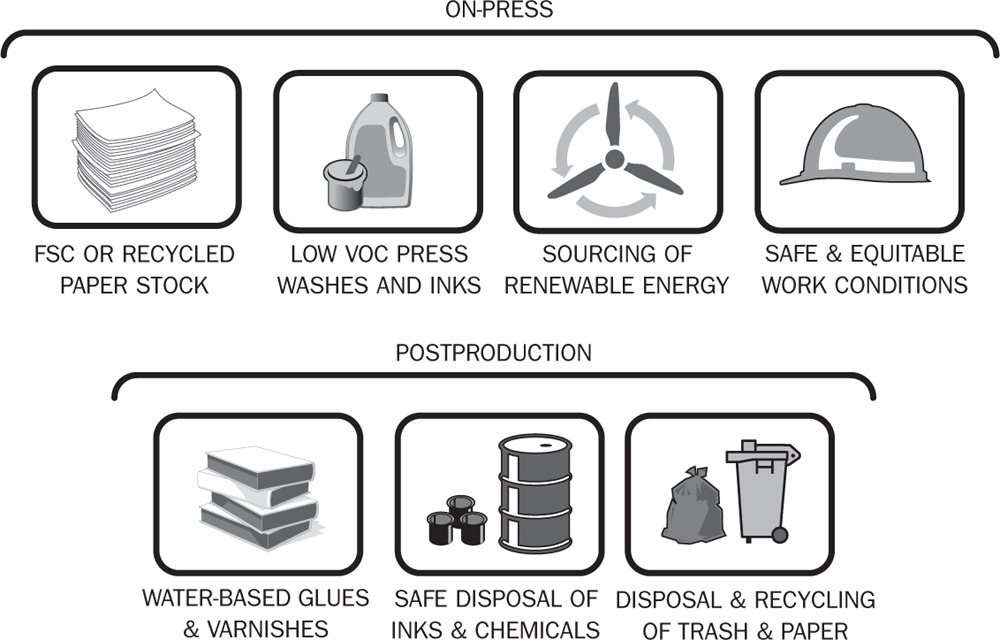
Fast Steps To Greener Printing
WHAT YOU CAN DO:
• Use less paper by specifying lighter-weight paper, using both sides, and designing with standard sizes to get the most out of each sheet.
• Choose paper that is totally chlorine-free with high postconsumer recycled content or that is FSC certified.
• Avoid neon and metallic inks.
• Use water-based, nonchlorinated glues and coatings.
• Avoid printing more than you need.
• For small jobs, use digital printing.
• Specify the use of waterless lithography when possible.
WHAT YOUR PRINTER CAN DO:
• Use the most environmentally preferable inks and cleaners with low or no VOCs.
• Have programs in place to reduce water and energy use.
• Recycle as much as possible.
• Safely dispose of waste.
Inks and Washes
It is fairly common to hear soy inks being touted as an environmentally preferable option. Unfortunately, the benefits of soy are more hype than reality. The soy oil used in ink is similar to, and not any better than, ink made out of other vegetable-based materials (such as linseed or cottonseed oil) that have been in use for hundreds of years. Ink that is labeled soy is often less than 15 percent soy-based and some environmental organizations discourage buyers from specifying soy ink because soybeans are the crop most frequently planted in places where rainforests are cut and burned. In general, vegetable-based inks are better than inks that use petroleum (a nonrenewable resource) as a medium, however it is not necessary to specify soy in particular. Regardless of what kind of vegetable-based ink a printer may use, it is always prudent to ask what percentage of vegetable oil the ink includes since there are no regulations that stipulate a minimum percentage.
The most important environmental ramification of ink and other solutions used in offset lithography is the release of volatile organic compounds during the printing. VOCs are fumes emitted from solvents, inks, and cleaners used in the printing process. Prolonged exposure to VOCs can have negative effects on a person’s health, and VOCs are a major contributor to ozone in the lower atmosphere. In recent years, companies have introduced products that have significantly reduced or even eliminated the VOCs emitted by inks, solvents, and press washes.
On the Horizon—Waterless Printing
Waterless printing offers significant advantages even when compared with other environmentally conscious offset printing methods. Unlike conventional offset lithography—a chemical process that requires water and dampening solutions—waterless printing uses a specific temperature range to transfer ink to the substrate. The elimination of water—and fountain solutions that contain isopropyl alcohol or their substitutes—vastly reduces the amount of water used and VOCs emitted on press. Waterless printing is also more efficient; printers that have switched to waterless printing report increased productivity of more than 100 percent. Unfortunately, so few printers offer this service that there is a great deal of misunderstanding about the technology. The truth is that waterless is cost effective and can be used to produce everything that would be printed with traditional offset lithography.
Digital Printing
Digital printing is usually considered environmentally preferable for jobs requiring fewer than 2,000 copies. It is also a good option for larger pieces such as signage or banners. Digital printing includes toner-based printers such as laser printers, which use heat to adhere dry pigment to paper, as well as ink-jet systems, which spray water and solvent-based ink directly onto paper or other printing material. Digital printing is environmentally preferable because toner inks don’t use any alcohol or emit VOCs, and even ink-jet printing has virtually eliminated off-gassing.
One of the main benefits of digital printing is that it doesn’t require messy cleanup. Some companies have programs that allow used ink cartridges and other printing waste (such as printer components and used ink depositories) to be returned to the manufacturer for recycling. In the case of ink-jet printing, there are new environmentally friendly papers, manmade and natural, that can be run in both small and wide-format printers.
GUIDE TO ENVIRONMENTALLY FRIENDLY PAPERS
The following chart shows brands and sheets of paper that have made an effort to decrease their negative impact on the environment. These are only a small sampling of companies and products that are available. If you have a preferred vendor, it is likely that they carry some FSC certified and/or PCW recycled paper. Comparing products from different companies can help consumers choose the best paper for their job and assess specific environmental and social targets.
| CASCADES ROLLAND ENVIRO100 PRINTMATTE | |
| Color Finishes | Smooth Opaque |
| Brightness | |
| Printing | Offset |
| FSC Certified | Yes |
| Recycled (PCW) | 100% |
| Carbon Neutral Green Power | Biomass Renewable |
| Elemental Chlorine Free | Most costly option. Requires more production time. Requires signatures. |
| COSTA RICA NATURAL PAPER BANANA | |
| Color Finishes | Textured |
| Brightness | Colored |
| Printing | Digital Offset |
| FSC Certified | No |
| Recycled (PCW) | 5-15% Banana Fiber 85-95% PCW |
| Carbon Neutral Green Power | No |
| Elemental Chlorine Free | Process Chlorine Free |
| DOMTAR EARTHCOTE | |
| Color Finishes | White Gloss Matte |
| Brightness | White 84 GE |
| Printing | Offset |
| FSC Certified | Yes |
| Recycled (PCW) | 30% PCW |
| Carbon Neutral Green Power | No |
| Elemental Chlorine Free | No |
| DOMTAR OPAQUE PLAINFIELD | |
| Color Finishes | White 3 Colors Smooth Vellum |
| Brightness | 96 GE |
| Printing | Copier Digital Offset Ink-Jet |
| FSC Certified | Yes |
| Recycled (PCW) | None |
| Carbon Neutral Green Power | No |
| Elemental Chlorine Free | No |
| DOMTAR EARTH CHOICE OFFICE PAPER | |
| Color Finishes | White Smooth |
| Brightness | 92 GE |
| Printing | Laser Copier DI Presses Ink-Jet |
| FSC Certified | Yes |
| Recycled (PCW) | None |
| Carbon Neutral Green Power | No |
| Elemental Chlorine Free | No |
| FRENCH PAPER DUR-O-TONE | |
| Color Finishes | White Colors |
| Brightness | |
| Printing | Offset |
| FSC Certified | No |
| Recycled (PCW) | 100% |
| Carbon Neutral Green Power | Yes Hydro Powered |
| Elemental Chlorine Free | Process Chlorine Free |
| FOX RIVER EVERGREEN | |
| Color Finishes | Balanced White Soft White |
| Brightness | |
| Printing | Offset |
| FSC Certified | Yes |
| Recycled (PCW) | 50% PCW 50% Bamboo |
| Carbon Neutral Green Power | Yes |
| Elemental Chlorine Free | Elemental Chlorine Free PCW is Process Chlorine Free |
| GILBERT PAPER GILBERT COTTON | |
| Color Finishes | Pure Ultra White Cotton Cream |
| Brightness | Cockle Finish |
| Printing | Offset Recycled is Laser Ink-Jet Ready |
| FSC Certified | No |
| Recycled (PCW) | 100% Cotton Fibers or 100% PCW Cotton |
| Carbon Neutral Green Power | Yes |
| Elemental Chlorine Free | Elemental Chlorine Free |
| MOHAWK STRATHMORE SCRIPT | |
| Color Finishes | Colors White |
| Brightness | 96 Bright |
| Printing | Digital Offset |
| FSC Certified | Yes |
| Recycled (PCW) | 30% PCW |
| Carbon Neutral Green Power | Wind Power |
| Elemental Chlorine Free | No |

